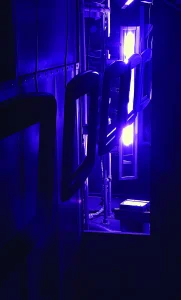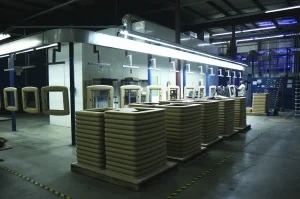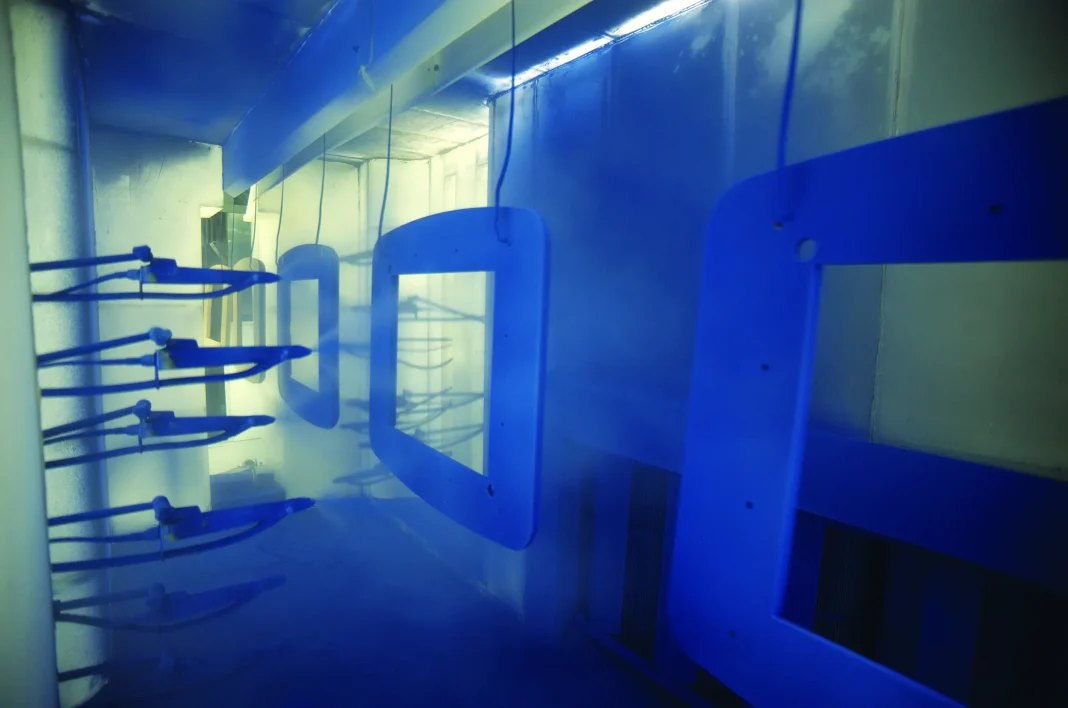By Lara Copeland, contributing writer, UV+EB Technology
 Located in Cleveland, Ohio, and occupying adjacent buildings, Keyland Polymer and DVUV have found ways to collaborate well beyond their physical proximity. As an innovator in the application of UV-cured powder coating on medium-density fiberboard (MDF), DVUV specializes in custom powder-coated components or parts for the retail, store fixture, POP display, healthcare, educational and office furniture industries. Its largest volume application is contract furniture, but this mid- to high-volume manufacturer with an automated line also supplies finished components for products such as fixture/displays, tabletops, shelving, wall panels, cabinetry and signage. Keyland Polymer develops, formulates, manufactures and sells the UV-cured powder coatings to DVUV and other customers for MDF, as well as other substrates including plastic, composites, metal and other materials.
Located in Cleveland, Ohio, and occupying adjacent buildings, Keyland Polymer and DVUV have found ways to collaborate well beyond their physical proximity. As an innovator in the application of UV-cured powder coating on medium-density fiberboard (MDF), DVUV specializes in custom powder-coated components or parts for the retail, store fixture, POP display, healthcare, educational and office furniture industries. Its largest volume application is contract furniture, but this mid- to high-volume manufacturer with an automated line also supplies finished components for products such as fixture/displays, tabletops, shelving, wall panels, cabinetry and signage. Keyland Polymer develops, formulates, manufactures and sells the UV-cured powder coatings to DVUV and other customers for MDF, as well as other substrates including plastic, composites, metal and other materials.
DVUV/Keyland Polymer Marketing Manager Rebecca Lonczak explained that DVUV does not work with natural wood and instead solely works with MDF due to its consistent uniformity of particle source, density and moisture content. “MDF is easily machinable and has a homogenous surface. Natural woods can be powder coated; however, the finish may be inconsistent, and issues can arise with outgassing and pinholes due to varying resin and moisture content in the wood,” she said.
The density, fiber, resin and moisture content in natural woods vary greatly by wood type, in addition to the location where it is grown. Every tree is different, even within the same species. Since the powder-coating process uses heat to melt the powder, heat – even at a low temperature with short exposure – can cause an uncontrollable response in natural wood. This makes powder coating natural wood with a consistent finish especially problematic. UV powder coating of MDF produces a more consistent and visually pleasing finish.
Keyland Polymer manufactures UV-cured powder coatings by combining resins, pigments, performance additives and photoinitiators. Photoinitiators are the key ingredient; they absorb the high-intensity ultraviolet light, producing and activating free radicals that crosslink the coating. This is a molecular crosslinking throughout the coating and is the instantaneous curing phase. “As soon as the photoinitiators are exposed to UV, crosslinking occurs, and the coating is cured instantly,” Lonczak said.
Additives enhance the coating surface by modifying or adjusting a specific property – scratch or mar resistance, gloss and texture. Pigments produce color and opacity. UV powder coatings are produced in the same manner and on the same type of equipment as thermal powder coatings – blended, extruded, chilled, chipped, milled, classified, sieved and packaged.
To achieve cure, it is necessary to match the photoinitiator type and amount to the UV source, including the proper combination of UV energy dose, intensity and wavelength. Several types of medium-pressure mercury vapor UV lamps are available for UV curing of powder coatings. Mercury lamps (“H” bulb) provide short wavelength UV energy (220–320 nm) that is suited for clear and tinted applications. Mercury lamps with an iron additive (“D” bulbs) provide higher wavelength energy (320–400 nm) that aid in curing for low-level pigmented systems. Lamps with a gallium additive (“V” bulb) provide a strong output of long wavelength energy (405–440 nm) and are the workhorse for pigmented systems. Long wavelength energy penetrates thicker and pigmented UV powder coatings.

The DVUV UV-cured powder coating process is fast. “It is a 20-minute, single-step process from raw MDF part to finished part ready to be packed and shipped,” Lonczak explained. To begin, the parts are hung on the line and prepared by spraying compressed air to remove any dust particles remaining from machining. Typically, surface sanding is not necessary prior to powder application. Next, the MDF parts enter a low-temperature preheat oven for one minute. “This allows the board to outgas before the coating is applied and brings the moisture in the MDF to the surface, making it conductive to attract the powder coating,” she added.
The UV powder then is electrostatically applied on the part using an automatic spray gun system. After application, the powder is melted or gelled in a low-temperature oven for one minute. Once melted, the part is instantly cured by exposure to UV lamps. In 20 minutes, the part is fully finished and ready to be packed and shipped to the customer.
UV-cured powder coatings were developed more than 20 years ago as an alternative to thermally cured powder coatings. Thermal curing requires 10 to 30 minutes or more to cure with high temperatures (around 400°F). The process time is longer and requires an additional cooling period prior to handling. As Lonczak pointed out, the main advantage UV curing has over thermal curing has to do with time and temperature. “The electrostatic powder application for UV-cured powder coating and thermoset powder coating are exactly the same; however, the separation of the melt/flow and the cure process functions is the differentiating characteristic between the two.”
The UV curing process is instantaneous and only requires a short, one-minute preheat to melt/flow the powder with temperatures between 220°F and 240°F before curing with a UV source. The advantages of a significantly reduced process time and a lower overall temperature make the UV-cured powder coating process important where MDF is concerned. “Excessive heat and time exposure can result in cracking and other defects,” she noted.
Powder coating poses a few challenges, but DVUV has measures in place to overcome them. Moisture and temperature variances can alter the success of the finish, but are handled easily by controlling the process within a temperature-regulated plant. A humidifier ensures the MDF board maintains the correct moisture content prior to powder coating. Consistent product also is ensured by DVUV’s initial run set-ups and tests. Each part DVUV runs is custom based on the customer’s part specifications. “Line speed, spray gun distance and processing temperatures are different and modified for each job we run,” she concluded.
The production team sets up trial runs in addition to performing checks during runs to ensure quality. A series of destructive and non-destructive tests are performed on the finished parts for quality control: a visual inspection comparing the part finish to the control standard, Tooke Gauge test (measures coating thickness), gloss level readings and MEK solvent-resistance tests. “Our production team also has a preventative maintenance, root cause analysis and corrective action plan when quality or process issues arise,” she concluded.
The future for powder-coated MDF at DVUV is bright. Government and regulatory agencies are restricting or eliminating the use of solvent-based liquid coatings. Waterborne liquid coatings are difficult to use on MDF, making UV-cured powder coatings an ideal finishing solution for MDF. UV-cured powder coating is solvent free, non-toxic and contains no volatile organic compounds or hazardous air pollutants. No special permits are required for handling. DVUV is seeing an increased sales demand from furniture and MDF component manufacturers looking for a reliable supplier of high-quality, environmentally beneficial and cost-effective finished MDF components.







